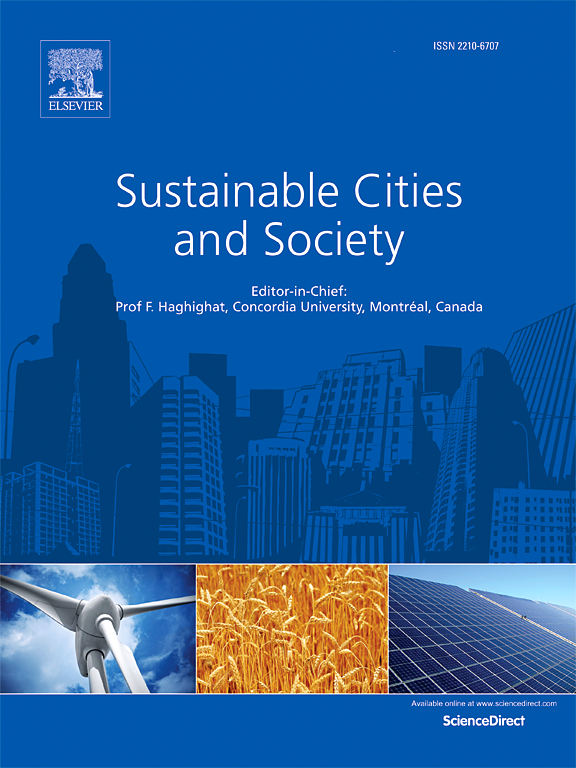基于TOPSIS方法的住宅小区室外热舒适动态时空评价:干旱气候的新方法
IF 10.5
1区 工程技术
Q1 CONSTRUCTION & BUILDING TECHNOLOGY
引用次数: 0
摘要
了解居住区的室外热舒适(OTC)对于气候响应型城市规划至关重要,特别是在干旱气候下。虽然OTC已经在城乡尺度上进行了研究,但不同建筑形式的城市内部变化仍未得到充分探索。炎热干旱地区的城市地区存在着显著的热应力,但仍缺乏有效的热脆弱区识别方法。本研究使用当地气候区(LCZ)分类来分析印度斋浦尔夏季、冬季和秋季的气温变化。在每个季节进行连续7天的实证调查。然后应用TOPSIS方法根据lcz与最优热条件的接近程度对其进行排名。这种方法有助于识别热脆弱地区和有效的城市配置。本研究的新颖之处在于使用TOPSIS方法系统地、经济有效地评估城市气候规划的热舒适。结果表明,lcz32在夏季表现出最有利的热条件,而lcz2则表现出最大的热应力。在冬季,LCZ 41在白天最舒适,LCZ 32在夜间最舒适。季节对比显示,各区域间的温度变化比区域内的温度变化更为明显,冬季最大热岛强度为11.35°C,夏季为10.38°C,秋季为9.25°C。值得注意的是,具有非均匀建筑高度的LCZ表现出较小的日温度波动,而具有有机结构特征的LCZ 9表现优于正交LCZ 6。该研究强调了热制图作为城市气候适应战略工具的必要性,为减轻热应力提供了一种新的方法框架。本文章由计算机程序翻译,如有差异,请以英文原文为准。

Spatio-temporal assessment of outdoor thermal comfort dynamics in residential neighbourhoods using the TOPSIS method: A novel approach for arid climates
Understanding outdoor thermal comfort (OTC) in residential neighbourhoods is vital for climate-responsive urban planning, particularly in arid climates. While OTC has been studied at the urban–rural scale, intra-urban variations across different built forms remain underexplored. Urban areas in hot and arid regions experience significant thermal stress, yet effective methods for identifying thermally vulnerable zones are still lacking.
This study uses the Local Climate Zone (LCZ) classification to analyze air temperature variations in Jaipur, India, across the summer, winter, and autumn seasons. Empirical surveys were conducted over seven consecutive days in each season. The TOPSIS method was then applied to rank LCZs based on their proximity to optimal thermal conditions. This approach facilitated the identification of thermally vulnerable areas and efficient urban configurations. The novelty of this study is the use of the TOPSIS method to systematically and cost-effectively assess thermal comfort for urban climate planning.
Results indicate that LCZ 32 exhibited the most favorable thermal conditions in summer, whereas LCZ 2 experienced the highest thermal stress. In winter, LCZ 41 was the most thermally comfortable during the day, while LCZ 32 remained optimal at night. Seasonal comparisons revealed that temperature variations were more pronounced between LCZs than within them, with maximum UHI intensities reaching 11.35 °C in winter, 10.38 °C in summer, and 9.25 °C in autumn. Notably, LCZs with non-uniform building heights exhibited reduced diurnal temperature fluctuations, and LCZ 9, characterized by an organic configuration, outperformed the orthogonal LCZ 6.
The study underscores the need for thermal mapping as a strategic tool for urban climate adaptation, providing a novel methodological framework to mitigate thermal stress.
求助全文
通过发布文献求助,成功后即可免费获取论文全文。
去求助
来源期刊

Sustainable Cities and Society
Social Sciences-Geography, Planning and Development
CiteScore
22.00
自引率
13.70%
发文量
810
审稿时长
27 days
期刊介绍:
Sustainable Cities and Society (SCS) is an international journal that focuses on fundamental and applied research to promote environmentally sustainable and socially resilient cities. The journal welcomes cross-cutting, multi-disciplinary research in various areas, including:
1. Smart cities and resilient environments;
2. Alternative/clean energy sources, energy distribution, distributed energy generation, and energy demand reduction/management;
3. Monitoring and improving air quality in built environment and cities (e.g., healthy built environment and air quality management);
4. Energy efficient, low/zero carbon, and green buildings/communities;
5. Climate change mitigation and adaptation in urban environments;
6. Green infrastructure and BMPs;
7. Environmental Footprint accounting and management;
8. Urban agriculture and forestry;
9. ICT, smart grid and intelligent infrastructure;
10. Urban design/planning, regulations, legislation, certification, economics, and policy;
11. Social aspects, impacts and resiliency of cities;
12. Behavior monitoring, analysis and change within urban communities;
13. Health monitoring and improvement;
14. Nexus issues related to sustainable cities and societies;
15. Smart city governance;
16. Decision Support Systems for trade-off and uncertainty analysis for improved management of cities and society;
17. Big data, machine learning, and artificial intelligence applications and case studies;
18. Critical infrastructure protection, including security, privacy, forensics, and reliability issues of cyber-physical systems.
19. Water footprint reduction and urban water distribution, harvesting, treatment, reuse and management;
20. Waste reduction and recycling;
21. Wastewater collection, treatment and recycling;
22. Smart, clean and healthy transportation systems and infrastructure;
 求助内容:
求助内容: 应助结果提醒方式:
应助结果提醒方式:


